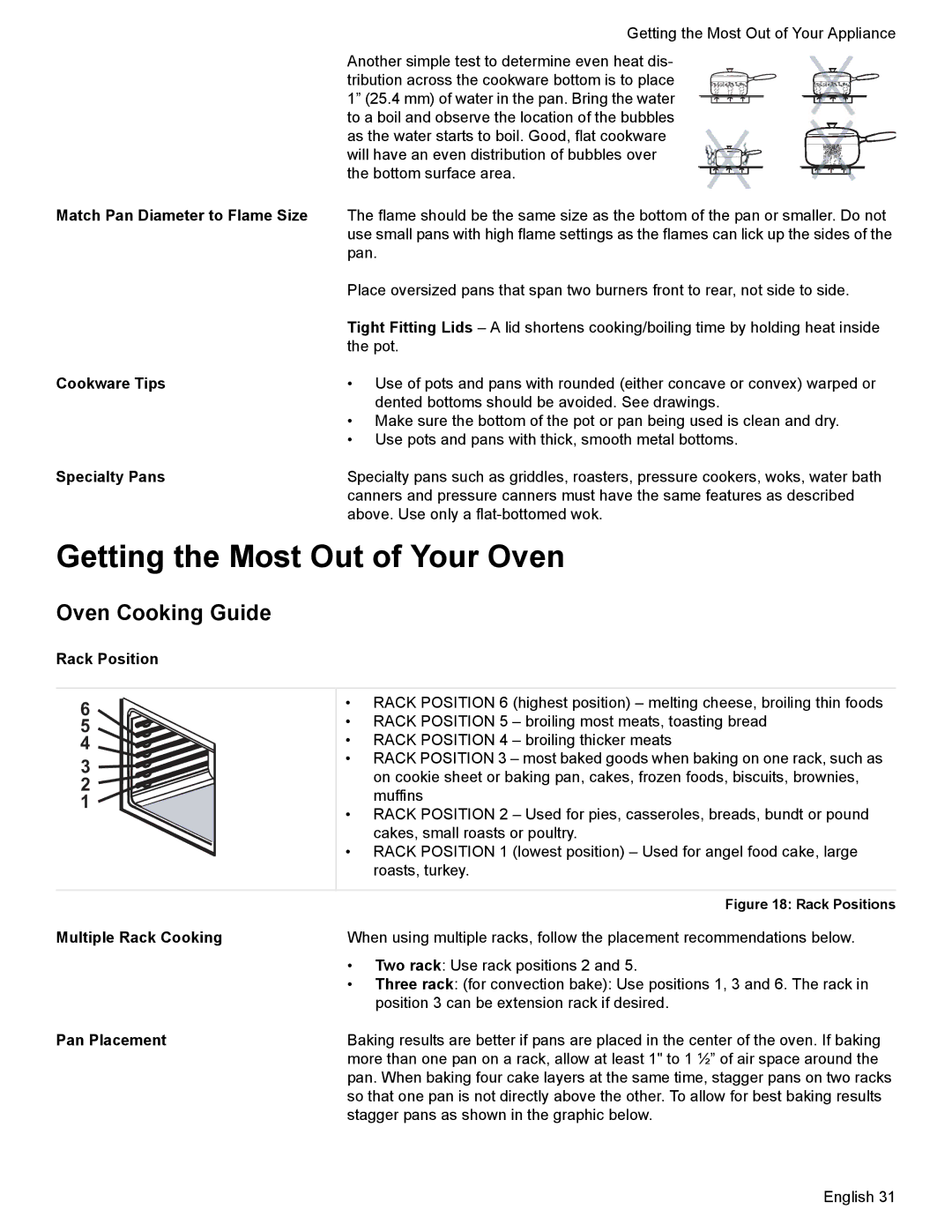
Getting the Most Out of Your Appliance
| Another simple test to determine even heat dis- | ||||||||||||||||||||
| tribution across the cookware bottom is to place |
|
|
|
|
|
|
|
|
|
|
|
|
|
|
|
|
|
| ||
|
|
| |||||||||||||||||||
| 1” (25.4 mm) of water in the pan. Bring the water |
|
|
|
|
|
|
|
|
|
|
|
|
|
|
|
|
|
|
| |
|
|
|
|
|
|
|
|
|
|
|
|
|
|
|
|
|
|
|
| ||
|
|
|
|
|
|
|
|
|
|
|
|
|
|
|
|
|
|
|
| ||
| to a boil and observe the location of the bubbles | ||||||||||||||||||||
| as the water starts to boil. Good, flat cookware |
|
|
|
|
| |||||||||||||||
|
| ||||||||||||||||||||
| will have an even distribution of bubbles over |
|
|
|
|
|
|
|
|
|
|
|
|
|
|
| |||||
|
| ||||||||||||||||||||
|
|
|
|
|
|
|
|
|
|
|
|
|
|
|
|
|
|
| |||
| the bottom surface area. |
|
|
|
|
|
|
|
|
|
|
|
|
|
|
|
|
|
|
|
|
|
|
|
|
|
|
|
|
|
|
|
|
|
|
|
|
|
|
|
|
| |
Match Pan Diameter to Flame Size | The flame should be the same size as the bottom of the pan or smaller. Do not | ||||||||||||||||||||
| use small pans with high flame settings as the flames can lick up the sides of the | ||||||||||||||||||||
| pan. | ||||||||||||||||||||
| Place oversized pans that span two burners front to rear, not side to side. | ||||||||||||||||||||
| Tight Fitting Lids – A lid shortens cooking/boiling time by holding heat inside | ||||||||||||||||||||
| the pot. | ||||||||||||||||||||
Cookware Tips | • Use of pots and pans with rounded (either concave or convex) warped or | ||||||||||||||||||||
| dented bottoms should be avoided. See drawings. | ||||||||||||||||||||
| • Make sure the bottom of the pot or pan being used is clean and dry. | ||||||||||||||||||||
| • Use pots and pans with thick, smooth metal bottoms. | ||||||||||||||||||||
Specialty Pans | Specialty pans such as griddles, roasters, pressure cookers, woks, water bath | ||||||||||||||||||||
| canners and pressure canners must have the same features as described | ||||||||||||||||||||
| above. Use only a | ||||||||||||||||||||
Getting the Most Out of Your Oven
Oven Cooking Guide
Rack Position
6
5
4
3
2
1
•RACK POSITION 6 (highest position) – melting cheese, broiling thin foods
•RACK POSITION 5 – broiling most meats, toasting bread
•RACK POSITION 4 – broiling thicker meats
•RACK POSITION 3 – most baked goods when baking on one rack, such as on cookie sheet or baking pan, cakes, frozen foods, biscuits, brownies, muffins
•RACK POSITION 2 – Used for pies, casseroles, breads, bundt or pound cakes, small roasts or poultry.
•RACK POSITION 1 (lowest position) – Used for angel food cake, large roasts, turkey.
| Figure 18: Rack Positions |
Multiple Rack Cooking | When using multiple racks, follow the placement recommendations below. |
| • Two rack: Use rack positions 2 and 5. |
| • Three rack: (for convection bake): Use positions 1, 3 and 6. The rack in |
| position 3 can be extension rack if desired. |
Pan Placement | Baking results are better if pans are placed in the center of the oven. If baking |
| more than one pan on a rack, allow at least 1" to 1 ½” of air space around the |
| pan. When baking four cake layers at the same time, stagger pans on two racks |
| so that one pan is not directly above the other. To allow for best baking results |
| stagger pans as shown in the graphic below. |
English 31
